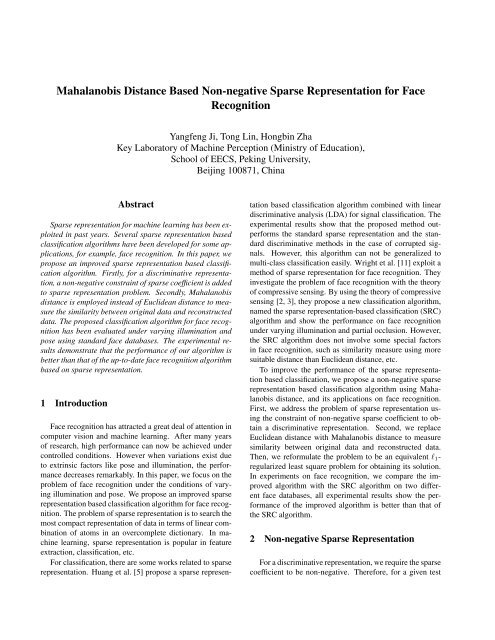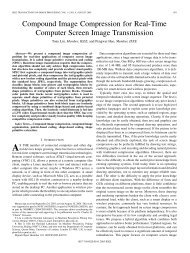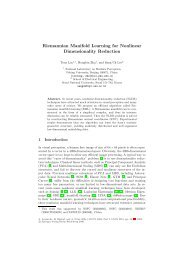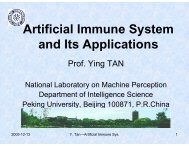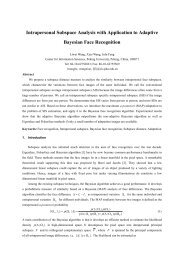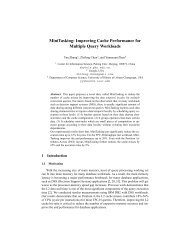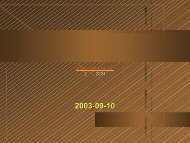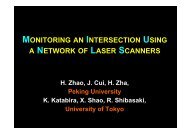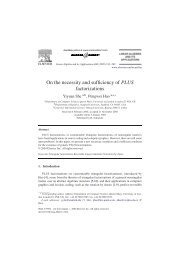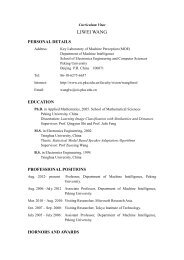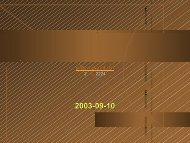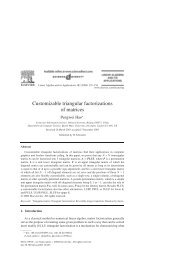Mahalanobis Distance Based Non-negative Sparse Representation for
Mahalanobis Distance Based Non-negative Sparse Representation for
Mahalanobis Distance Based Non-negative Sparse Representation for
Create successful ePaper yourself
Turn your PDF publications into a flip-book with our unique Google optimized e-Paper software.
<strong>Mahalanobis</strong> <strong>Distance</strong> <strong>Based</strong> <strong>Non</strong>-<strong>negative</strong> <strong>Sparse</strong> <strong>Representation</strong> <strong>for</strong> Face<br />
Recognition<br />
Yangfeng Ji, Tong Lin, Hongbin Zha<br />
Key Laboratory of Machine Perception (Ministry of Education),<br />
School of EECS, Peking University,<br />
Beijing 100871, China<br />
Abstract<br />
<strong>Sparse</strong> representation <strong>for</strong> machine learning has been exploited<br />
in past years. Several sparse representation based<br />
classification algorithms have been developed <strong>for</strong> some applications,<br />
<strong>for</strong> example, face recognition. In this paper, we<br />
propose an improved sparse representation based classification<br />
algorithm. Firstly, <strong>for</strong> a discriminative representation,<br />
a non-<strong>negative</strong> constraint of sparse coefficient is added<br />
to sparse representation problem. Secondly, <strong>Mahalanobis</strong><br />
distance is employed instead of Euclidean distance to measure<br />
the similarity between original data and reconstructed<br />
data. The proposed classification algorithm <strong>for</strong> face recognition<br />
has been evaluated under varying illumination and<br />
pose using standard face databases. The experimental results<br />
demonstrate that the per<strong>for</strong>mance of our algorithm is<br />
better than that of the up-to-date face recognition algorithm<br />
based on sparse representation.<br />
1 Introduction<br />
Face recognition has attracted a great deal of attention in<br />
computer vision and machine learning. After many years<br />
of research, high per<strong>for</strong>mance can now be achieved under<br />
controlled conditions. However when variations exist due<br />
to extrinsic factors like pose and illumination, the per<strong>for</strong>mance<br />
decreases remarkably. In this paper, we focus on the<br />
problem of face recognition under the conditions of varying<br />
illumination and pose. We propose an improved sparse<br />
representation based classification algorithm <strong>for</strong> face recognition.<br />
The problem of sparse representation is to search the<br />
most compact representation of data in terms of linear combination<br />
of atoms in an overcomplete dictionary. In machine<br />
learning, sparse representation is popular in feature<br />
extraction, classification, etc.<br />
For classification, there are some works related to sparse<br />
representation. Huang et al. [5] propose a sparse representation<br />
based classification algorithm combined with linear<br />
discriminative analysis (LDA) <strong>for</strong> signal classification. The<br />
experimental results show that the proposed method outper<strong>for</strong>ms<br />
the standard sparse representation and the standard<br />
discriminative methods in the case of corrupted signals.<br />
However, this algorithm can not be generalized to<br />
multi-class classification easily. Wright et al. [11] exploit a<br />
method of sparse representation <strong>for</strong> face recognition. They<br />
investigate the problem of face recognition with the theory<br />
of compressive sensing. By using the theory of compressive<br />
sensing [2, 3], they propose a new classification algorithm,<br />
named the sparse representation-based classification (SRC)<br />
algorithm and show the per<strong>for</strong>mance on face recognition<br />
under varying illumination and partial occlusion. However,<br />
the SRC algorithm does not involve some special factors<br />
in face recognition, such as similarity measure using more<br />
suitable distance than Euclidean distance, etc.<br />
To improve the per<strong>for</strong>mance of the sparse representation<br />
based classification, we propose a non-<strong>negative</strong> sparse<br />
representation based classification algorithm using <strong>Mahalanobis</strong><br />
distance, and its applications on face recognition.<br />
First, we address the problem of sparse representation using<br />
the constraint of non-<strong>negative</strong> sparse coefficient to obtain<br />
a discriminative representation. Second, we replace<br />
Euclidean distance with <strong>Mahalanobis</strong> distance to measure<br />
similarity between original data and reconstructed data.<br />
Then, we re<strong>for</strong>mulate the problem to be an equivalent l 1 -<br />
regularized least square problem <strong>for</strong> obtaining its solution.<br />
In experiments on face recognition, we compare the improved<br />
algorithm with the SRC algorithm on two different<br />
face databases, all experimental results show the per<strong>for</strong>mance<br />
of the improved algorithm is better than that of<br />
the SRC algorithm.<br />
2 <strong>Non</strong>-<strong>negative</strong> <strong>Sparse</strong> <strong>Representation</strong><br />
For a discriminative representation, we require the sparse<br />
coefficient to be non-<strong>negative</strong>. There<strong>for</strong>e, <strong>for</strong> a given test
sample, components of coefficient indicate the contributions<br />
of training samples. Furthermore, <strong>Mahalanobis</strong> distance<br />
is employed to measure the similarity between original<br />
data and reconstructed data, instead of Euclidean distance.<br />
2.1 <strong>Sparse</strong> representation in subspace<br />
Generally, given n high-dimensional data points A =<br />
{a 1 , . . . , a n }, some research on manifold learning, <strong>for</strong> instance<br />
LLE [10], has proved that these data lie on a lower dimensional<br />
manifold. Any data point a i ∈ A can be approximately<br />
represented by the linear combination of its neighboring<br />
data points. This kind of linear representation can be<br />
generalized to labeled data. Given data points {a 1 , . . . , a n }<br />
in one class, a new data point a ∗ in the same class can be<br />
represented as linear combination of {a 1 , . . . , a n },<br />
a ∗ = β 1 a 1 + . . . + β n a n . (1)<br />
In other words, given n training samples {a 1 , . . . , a n }, their<br />
linear combinations span a linear subspace X :<br />
X = span{a 1 , . . . , a n }.<br />
A new sample a ∗ in the same class approximately lie on this<br />
subspace.<br />
Linear representation <strong>for</strong> labeled data can be used in pattern<br />
recognition. Given sufficient K classes training samples,<br />
a basic problem in pattern recognition is to correctly<br />
determine the class which a new coming (test) sample belongs<br />
to. We arrange the n k training samples from the kth<br />
class as columns of a matrix A k = [a k,1 , . . . , a k,nk ] ∈<br />
R m×n k<br />
. Then, we obtain the training sample matrix A =<br />
[A 1 , . . . , A K ]. Under the assumption of linear representation,<br />
a test sample y ∈ R m will approximately lie on the<br />
linear subspace spanned by training samples,<br />
y = β 1,1 a 1,1 + . . . + β 1,n1 a 1,n1<br />
or, in matrix <strong>for</strong>m,<br />
+ . . .<br />
+β K,1 a K,1 + . . . + β K,nK a K,nK . (2)<br />
y = Ax ∈ R m , (3)<br />
where x is a coefficient vector. For accurate reconstruction<br />
of sample y in class k,<br />
x = [0, . . . , 0, β k,1 , . . . , β k,nk , 0, . . . , 0] T ∈ R n .<br />
If K is large, x will be sufficient sparse. However, <strong>for</strong> many<br />
practical problems, accurate reconstruction is nearly impossible.<br />
If m < n, Eq.(2) is under-determined, and its solution is<br />
not unique. This motivates us to solve the following optimization<br />
problem <strong>for</strong> a sparse solution:<br />
ˆx = arg min ‖x‖ 0 subject to Ax = y, (4)<br />
x<br />
where ‖ · ‖ 0 denotes the l 0 -norm, which counts the number<br />
of nonzero entries in a vector. However, the problem of<br />
finding the sparse solution of Eq.(4) is NP-hard, and difficult<br />
to solve.<br />
The theory of compressive sensing [2, 3] reveals that if<br />
the solution x is sparse enough, we can solve the following<br />
convex relaxed optimization problem to obtain approximate<br />
solution:<br />
ˆx = arg min ‖x‖ 1 subject to Ax = y (5)<br />
x<br />
Furthermore, supposing that the observations are inaccurate,<br />
we should relax the constraint in Eq.(5) and have the<br />
following optimization problem:<br />
ˆx = arg min ‖x‖ 1 subject to ‖Ax − y‖ 2 ≤ ε (6)<br />
x<br />
where ε is the tolerance of reconstruction error.<br />
Regularization is one of the most popular methods to<br />
deal with constrained optimization problems, <strong>for</strong> instance,<br />
in the theory of Support Vector Machine. For Eq.(6), that is<br />
ˆx = arg min ‖x‖ 1 + γ‖Ax − y‖ 2 2. (7)<br />
x<br />
where γ is a weight to make a trade-off between reconstruction<br />
error and sparsity in the representation.<br />
2.2 <strong>Non</strong>-<strong>negative</strong> constraint <strong>for</strong> sparse coefficient<br />
<strong>Sparse</strong> representation <strong>for</strong> classification is different from<br />
that <strong>for</strong> signal reconstruction. In signal processing, an original<br />
signal y should be reconstructed as accurately as possible.<br />
However, in classification, a discriminative representation<br />
is more important than reconstruction accuracy.<br />
For a discriminative representation, we require that coefficient<br />
x should indicate contributions of all training samples<br />
to a given test sample. There<strong>for</strong>e, we add constraint<br />
x ≥ 0 to Eq.(7)<br />
ˆx = arg min ‖x‖ 1 + γ‖Ax − y‖ 2 2, (8)<br />
x:x≥0<br />
where ˆx is sparse, in which all elements are non-<strong>negative</strong>.<br />
The sparse representation from Eq.(8) avoids “<strong>negative</strong>”<br />
contribution of some training samples. In this way, <strong>for</strong> a<br />
given test sample, the similar training samples can be found<br />
from sparse representation.<br />
2
2.3 Similarity measure using <strong>Mahalanobis</strong> distance<br />
For measure the similarity between original data and reconstructed<br />
data, We employ <strong>Mahalanobis</strong> distance instead<br />
of Euclidean distance. By introducing <strong>Mahalanobis</strong> distance,<br />
we obtain a generalized distance measure <strong>for</strong> face<br />
recognition, which can embody different weights on different<br />
components of feature vector. <strong>Mahalanobis</strong> <strong>Distance</strong><br />
has been proved as a better similarity measure than Euclidean<br />
distance, when it comes to pattern recognition problems,<br />
<strong>for</strong> instance, face recognition [9].<br />
Given two data points v 1 , v 2 ∈ R m , their <strong>Mahalanobis</strong><br />
distance is given by:<br />
d M (v 1 , v 2 ) = ‖v 1 − v 2 ‖ M<br />
√<br />
= (v 1 − v 2 ) T M(v 1 − v 2 ), (9)<br />
where M ∈ R m×m is a positive definite matrix.<br />
Using the definition of <strong>Mahalanobis</strong> distance, the distance<br />
between original data y and reconstructed data Ax is<br />
d M (Ax, y) = ‖Ax − y‖ M =<br />
√<br />
(Ax − y) T M(Ax − y).<br />
The objective function with <strong>Mahalanobis</strong> distance can be<br />
<strong>for</strong>mulated as follows:<br />
ˆx = arg min ‖x‖ 1 + γ‖Ax − y‖ 2 M . (10)<br />
x:x≥0<br />
There are three different types of positive definite M in<br />
the definition of <strong>Mahalanobis</strong> distance:<br />
• M is any positive definite matrix.<br />
• M is a diagonal matrix. If the type of M is diagonal,<br />
M gives different components with different weights.<br />
• M is a scalar multiple of the identity matrix I, M =<br />
σI, where σ > 0. If M = σI, Eq.(10) is equivalent to<br />
Eq.(8) with regularization coefficient σγ.<br />
In this paper, the matrix M is determined by the importance<br />
of components of feature vectors. Moreover, we can ingore<br />
the correlation among different dimensions.<br />
3 Algorithm<br />
Using the Cholesky factorization, the problem of <strong>Mahalanobis</strong><br />
distance based non-<strong>negative</strong> sparse representation<br />
can be solved by a standard optimization algorithm. Then,<br />
the classification algorithm is designed based on the idea of<br />
finding the minimal reconstruction error [11].<br />
3.1 Algorithm <strong>for</strong> solving non-<strong>negative</strong> l 1 -<br />
regularized least square<br />
Since M is a positive definite matrix, the Cholesky factorization<br />
of M is<br />
M = L T L, (11)<br />
where U is a lower triangular matrix with positive diagonal<br />
entries. From Eq.(11), the objective function in Eq.(10) can<br />
be <strong>for</strong>mulated as:<br />
ˆx = arg min ‖x‖ 1 + γ((Ax − y) T L T L(Ax − y))<br />
x:x≥0<br />
= arg min ‖x‖ 1 + γ((LAx − Ly) T (LAx − Ly))<br />
x:x≥0<br />
= arg min ‖x‖ 1 + γ‖LAx − Ly)‖ 2 . (12)<br />
x:x≥0<br />
Set A ′ = LA and y ′ = Ly. Given parameter γ > 0, the<br />
problem is equal to the following problem:<br />
ˆx = arg min ‖x‖ 1 + γ‖A ′ x − y ′ )‖ 2 2<br />
x:x≥0<br />
= arg min λ‖x‖ 1 + ‖A ′ x − y ′ ‖ 2 2, (13)<br />
x:x≥0<br />
where λ = γ −1 . Eq.(13) is a non-<strong>negative</strong> l 1 -regularized<br />
least square problem, which can be solved by second-order<br />
cone programming [1, 8].<br />
3.2 Recognition algorithm<br />
The recognition algorithm is inspired by the SRC algorithm<br />
proposed in [11]. Given a test sample y, we first compute<br />
its sparse coefficient ˆx. Then, we determine the class<br />
of this test sample from its reconstruction error between this<br />
test sample and the training samples of class k,<br />
E k (ˆx) = ‖Aδ k (ˆx) − y‖ M , (14)<br />
where residual error is computed using <strong>Mahalanobis</strong> distance.<br />
For each class k, δ k (x) : R n → R n is the characteristic<br />
function which selects the coefficients associated with<br />
the kth class. The class C(y) which test sample y belongs<br />
to is determined by<br />
C(y) = arg min E k (ˆx). (15)<br />
k<br />
The whole algorithm of our method is summarized in<br />
algorithm 1.<br />
4 Experiments<br />
In experiments, we test our algorithm on face recognition<br />
with two face databases: the extended Yale face database B<br />
3
Algorithm 1 Our algorithm<br />
Input: Test sample y, training matrix A, parameter γ<br />
1: Normalize the columns of A using l 2 norm<br />
2: Solve<br />
ˆx = arg min ‖x‖ 1 + γ‖Ax − y‖ 2 M<br />
x:x≥0<br />
using an equivalent non-<strong>negative</strong> l 1 -regularized least<br />
square problem<br />
3: Compute reconstruction error E k (k = 1, ..., K):<br />
E k (ˆx) = ‖Aδ k (ˆx) − y‖ M<br />
Output: C(y), where C(y) = arg min k E k (ˆx)<br />
and the Sheffield face database. For feature extraction, we<br />
downsample face images to some given sizes and reshape<br />
them to be column vectors. Then we arrange all column<br />
vector of training samples to be a matrix A in Eq.(10). For<br />
a test sample, y, our algorithm and the SRC algorithm [11]<br />
are employed to obtain the results of recognition.<br />
Figure 1. Sample faces from different persons<br />
under different illumination in the extended<br />
Yale face database B<br />
4.1 Illumination variant database — the extended<br />
Yale face database B<br />
First, we evaluate the per<strong>for</strong>mance of our algorithm on<br />
a cropped version of the Extended Yale Face Database<br />
B [7]. There are 2,427 face images of 38 individuals in<br />
this database. All images are cropped into size of 192×168<br />
pixels. There are different lighting conditions on each image<br />
<strong>for</strong> each subject(see Figure 1 <strong>for</strong> some examples). We<br />
randomly choose half of images in each class <strong>for</strong> training<br />
and the other images <strong>for</strong> testing. For feature extraction, we<br />
downsample all images to six different sizes: 30, 56, 72, 90,<br />
110 and 120.<br />
We compare the per<strong>for</strong>mance of our algorithm with that<br />
of the SRC algorithm [11] on different dimensions of features.<br />
As illustrated in Figure 2, our algorithm has better<br />
per<strong>for</strong>mance than the SRC algorithm. The best per<strong>for</strong>mance<br />
of our algorithm in this experiment is 96.74%,<br />
while the best per<strong>for</strong>mance of the SRC algorithm is 95.05%.<br />
As shown in this experiment, the classification accuracy is<br />
improved by non-<strong>negative</strong> coefficient constraint and <strong>Mahalanobis</strong><br />
distance.<br />
4.2 Pose variant database — the Sheffield face<br />
database<br />
In this section, the algorithm per<strong>for</strong>mance is tested on the<br />
subset of Sheffield (previously UMIST) face database [4].<br />
This subset of Sheffield face database consists of 495 face<br />
images of 18 individuals. Faces in the database cover range<br />
Figure 2. Comparsion of recognition rates of<br />
our algorithm and the SRC algorithm on the<br />
extended Yale face database B<br />
of poses from frontal view to profile. All persons in this<br />
database cover a mixed range of race, sex and age. Some<br />
images from Figure 3 are examples of this database.<br />
Features are extracted from all original images be<strong>for</strong>e<br />
pre<strong>for</strong>ming face recognition using downsampling. In this<br />
experiment, we downsample all images from size of 112 ×<br />
96 to different sizes, such as 6 × 5, 8 × 7, 9 × 8, etc. Then,<br />
all downsampling images are reshaped to column vectors<br />
as feature vectors. We divide all images to training samples<br />
and test samples: 94 training images and 401 test images.<br />
For each subject, there are about 5−9 images from different<br />
poses <strong>for</strong> training, and the other images <strong>for</strong> testing.<br />
We also compare the per<strong>for</strong>mance of our algorithm with<br />
that of the SRC algorithm on different dimensions of feature.<br />
In figure 4, we can see that our algorithm is slightly<br />
4
etter than the SRC algorithm. Ranging from different dimension,<br />
the best per<strong>for</strong>mance of our algorithm is 97.51%,<br />
compared with 96.26% of the SRC algorithm.<br />
Note that, when the dimension of feature continues to<br />
increase, the per<strong>for</strong>mance of the SRC algorithm decreases<br />
remarkably. For example, when the dimension of feature<br />
vector is 81, the recognition rate of the SRC algorithm is<br />
82.54%. The recognition rate of our algorithm is 96.51% at<br />
the same dimension.<br />
<strong>Mahalanobis</strong> distance. For a discriminative representation,<br />
a non-<strong>negative</strong> constraint of sparse coefficient is added.<br />
Moreover, <strong>Mahalanobis</strong> distance is used as a measure of<br />
image similarity instead of Euclidean distance in feature<br />
space. Then, we build a connection between this problem<br />
and non-<strong>negative</strong> l 1 -regularized least square problem. The<br />
experimental results on face recognition show that the per<strong>for</strong>mance<br />
of our algorithm is better than the SRC algorithm.<br />
In the future, we will apply the framework of <strong>Mahalanobis</strong><br />
distance based non-<strong>negative</strong> sparse representation to other<br />
fields, such as, object detection, etc.<br />
Acknowledgements<br />
The authors would like to thank the anonymous reviewers<br />
<strong>for</strong> their helpful suggestions and the helpful discussion<br />
with Wei Ma and Tao Luo. This work was partially<br />
supported by the National Science Foundation of<br />
China(NSFC) Grants 60775006, National Key Basic Research<br />
Program(NKBRP) Grant 2004CB318005, and the<br />
NHTRDP 863 Grant No. 2009AA01Z329.<br />
Figure 3. Sample faces from different persons<br />
under different pose in the Sheffield face<br />
database<br />
Figure 4. Comparsion of recognition rates of<br />
our algorithm and the SRC algorithm on the<br />
Sheffield face database<br />
5 Conclusion<br />
In this paper, we propose an improved classification algorithm<br />
based on non-<strong>negative</strong> sparse representation with<br />
References<br />
[1] S. Boyd and L. Vandenberghe. Convex Optimization. Cambridge<br />
University Press, 2004.<br />
[2] E. Candes. Compressive sampling. Int. Congress of Mathematics,<br />
3:1433–1452, 2006.<br />
[3] D. Donoho. Compressive sensing. IEEE Trans. on In<strong>for</strong>mation<br />
Theory, 52(4):1289–1306, Apr. 2006.<br />
[4] D. B. Graham and N. M. Allinson. Characterizing virtual<br />
eigensignatures <strong>for</strong> general purpose face recognition. In<br />
H. Wechsler, P. J. Phillips, V. Bruce, F. Fogelman-Soulie,<br />
and T. S. Huang, editors, Face Recognition: From Theory to<br />
Applications, NATO ASI Series F, Computer and Systems<br />
Sciences, pages 446–456, 1998.<br />
[5] K. Huang and S. Aviyente. <strong>Sparse</strong> representation <strong>for</strong> signal<br />
classification. In Proceedings of Neural In<strong>for</strong>mation Processing<br />
Systems, volume 19. MIT Press, 2006.<br />
[6] J. A. Lee and M. Verleysen. <strong>Non</strong>linear Dimensionality Reduction.<br />
In<strong>for</strong>mation Science and Statistics. Springer, 2007.<br />
[7] K. Lee, J. Ho, and D. Kriegman. Acquiring linear subspaces<br />
<strong>for</strong> face recognition under variable lighting. IEEE Transactions<br />
on Pattern Analysis and Machine Intelligence (PAMI),<br />
27(5):684–698, 2005.<br />
[8] M. Lobo, L. Vandenberghe, S. Boyd, and H. Lebret. Applications<br />
of second-order cone programming. Linear Algebra<br />
and its Applications, 284, Nov. 1998.<br />
[9] N. Ramanathan, R. Chellappa, and A. R. Chowdhury. Facial<br />
similarity across age, disguise, illumination and pose. In<br />
Proceedings of the International Conference on Image Processing(ICIP),<br />
2004.<br />
[10] S. Roweis and L. Saul. <strong>Non</strong>linear dimensionality reduction<br />
by locally linear embedding. Science, 229(5500):2323–<br />
2326, Dec. 2000.<br />
5
[11] J. Wright, A. Yang, A. Ganesh, S. Sastry, and Y. Ma. Robust<br />
face recognition via sparse representation. IEEE Transactions<br />
on Pattern Analysis and Machine Intelligence (PAMI),<br />
31(2), Feb. 2009.<br />
6


